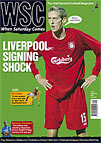 Robert Shaw tells us how in Brazil, increasing numbers of the country's star players are ploughing some of their riches back into community projects
Robert Shaw tells us how in Brazil, increasing numbers of the country's star players are ploughing some of their riches back into community projects
Alongside top of the range sports cars and (something) every leading Brazilian footballer these days wants to have a pet social project. Jorginho, the right back in Brazil’s 1994 World Cup winning team, was already thinking of setting up an education schheme as he extended a playing career that had included spells with Flamengo, Bayern Leverkusen and Kashima Antlers. It eventually came to fruition when Bola pra Frente (Move the Ball Forward) was launched on June 29, 200 in his birthplace of Guadalupe in Rio de Janeiro’s sprawling northern suburbia, overlooked by the spartan block of flats where he grew up. “When we brought the site where Bola pra Frente is today it was an area overgrown with bushes, with horses and pigs running around, he says. “What makes me happy is to look at the same place now and see a very different picture: children playing sport, learning about citizenship and building a better future.”
The scheme provides classes developing literacy and computer skills alongside football and other sporting activities such as karate and dance for more than 700 children between the ages of six and 16. Those identified as particularly talented footballers also have the chance for more advanced coaching. Students can only join if they maintain regular attendance at classes in the underfunded public school system.
Different phases of the project use terminology borrowed from the Brazilian game. Six- to nine-year-olds participate in the Craque de Bola e Escola (Star with the Ball and at School) before moving on to the Artilheiro (Leading Scorer) phase offered to students from ten to 14. The mission statement of the project is to take “the children from the streets and the streets from the children” in an area where violence connected to drug warfare and social exclusion is commonplace.
Even at a basic level the project is performing services neglected by public agencies. “This is the only library in the neighbourhood,” a project manager told me during a recent visit.
Among other projects established or supported by leading players, the best-known are the Fundação Cafu set up by Brazil’s captain in his home district of Jardim Irene, which received global publicity via the shirt he wore when he lifted the 2002 World Cup, and the Fundação Gol de Letra created by Jorginho’s team-mates from 94, Rai and Leonardo. Gol de Letra has bases in São Paulo and Leonardo’s native Niteroi, the commuter city adjacent to Rio that has its share of favelas. Cynics might wonder whether the projects are much more than socially-conscious fashion accessories but for many players the bonds seem strong. During his absence from the Confederations Cup Cafu was busy back in Brazil helping to publicise new fundraising activities. Meanwhile, Roberto Carlos and Gilberto Silva are fully involved in social works in their home regions, while Ronaldo is mobbed whenever he visits the projects he now supports in the Cidade de Deus community made famous in the eponymous film.
Many players spend time on their projects when back in Brazil during the short breaks between European seasons, with funds raised through regular benefit matches at which spectators are invited to donate non-perishable foodstuffs such as rice, beans or coffee.
Another aspect of the projects that has developed is their professionalism. Projects such as Bola pra Frente and Gol de Letra have full-time administrative staff, specialists in educational psychology and sections devoted to generating revenue. For business there is also an undoubted attraction to being associated with football. This has attracted companies such as HSBC and Claro to Bola pra Frente and encouraged investment from Petrobras, Nike and others in the case of Gol de Letra. Sponsorship, even from controversial sources, is seen as essential to cover costs and to extend the community services provided by staff and volunteers.
From WSC 223 September 2005. What was happening this month